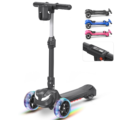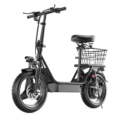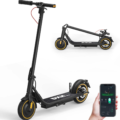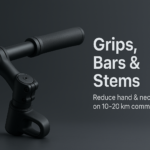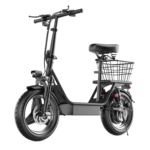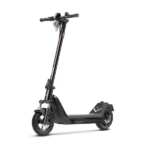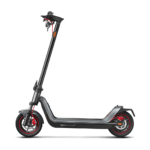- Home
- Scooters
- Electric Scooters
- DXH Max Pro
DXH Max Pro


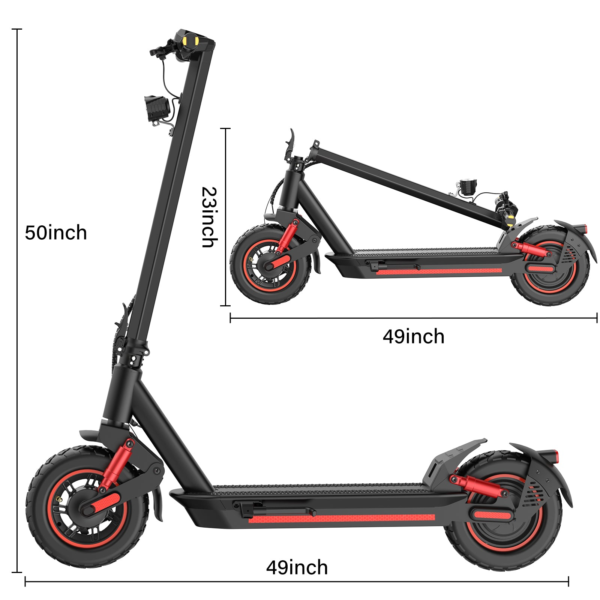
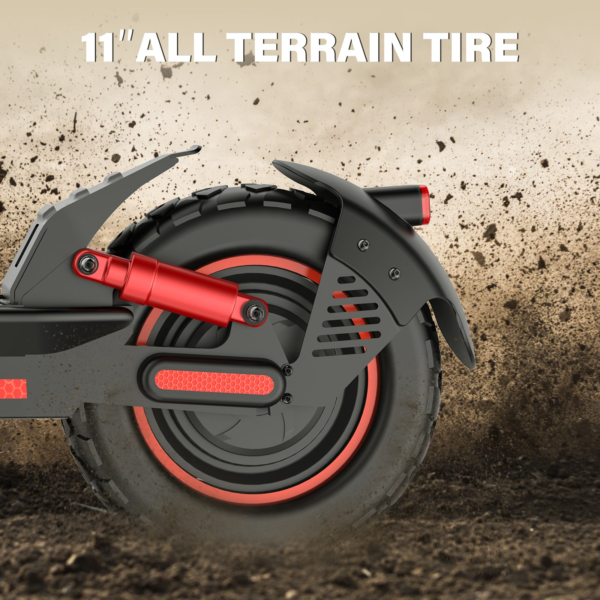
- Battery Range: Not specified
- Top Speed: 30 mph (48 km/h)
- Motor Power: Not specified
- Weight Capacity: 264 lb (120 kg)
- Charging Time: Not specified
- Scooter Weight: 46.3 lb (21.0 kg)
PROS
- 30 mph (48 km/h) top speed
- 11″ pneumatic tires
- Front & rear suspension (4 shocks)
- Full lighting incl. turn signals
- 264 lb (120 kg) max load
CONS
- Range not specified
- Battery capacity not listed
- IP rating not specified
- Heavier than basic commuters
Table of contents
- What Is the DXH Max Pro?
- How the DXH Max Pro Works
- Key Specifications
- Design & Build Quality
- Performance Fundamentals
- Battery, Range & Efficiency
- Ride Quality & Comfort
- Braking & Safety Features
- Portability & Daily Usability
- Maintenance & Care
- Weather & Seasonal Considerations
- DXH Max Pro vs Alternatives
- Who the DXH Max Pro Is (and Isn’t) For
- FAQs
- Glossary
- Final Thoughts
If you want a commuter-friendly scooter that still feels lively, the DXH Max Pro aims to split the difference between everyday practicality and brisk performance. It pairs large 11-inch pneumatic tires with quad suspension and a claimed 1000-watt peak motor. As a result, it targets riders who want stable handling, confident braking, and a fold-and-go design for daily trips. For younger riders who need a smaller, gentler platform, consider the DXH Kids e-scooter.
Below, you’ll find a clear, test-style DXH Max Pro overview. We explain how it works, what the manufacturer claims, and how those claims translate to real streets. You’ll also get maintenance guidance, seasonal tips, and straightforward answers to common questions.
What Is the DXH Max Pro?
The DXH Max Pro is an adult electric scooter oriented toward urban travel. It emphasizes:
- Power and speed: a manufacturer-quoted 1000 W peak motor and a top speed up to 30 mph (≈48 km/h).
- Ride comfort: 11-inch pneumatic tires and four shock absorbers designed to smooth broken pavement.
- Daily utility: a folding mechanism, complete lighting, turn signals, and side reflectors for visibility.
- Manageable weight: a listed 46.3 lb (≈21.0 kg) carry mass that you can lift into a trunk or up a short flight of stairs.
- Load rating: up to 264 lb (≈120 kg) rider capacity.
In short, the DXH Max Pro is built for riders who want a calmer ride than small-wheel commuters provide, yet who still need a quick-folding package for trains, elevators, and apartment storage.
How the DXH Max Pro Works
Electric scooters all follow the same basic template. However, details matter, and the DXH Max Pro leans into comfort and control.
Motor & Controller.
When you press the throttle, the controller meters battery power to the hub motor. Because the Max Pro lists 1000 W peak, it can deliver short bursts for starts, lane merges, and hill crests. Think of the controller as a faucet and the motor as a waterwheel: opening the faucet increases flow (current), which turns the motor harder. Peak numbers reflect momentary surge; sustained output is usually lower to protect the system.
Battery.
The battery stores energy that the controller pulls in pulses. While the maker does not publish a voltage or capacity, you still manage it the same way as any urban scooter: avoid deep discharges, charge at room temperature when possible, and give it time to balance at 100% every so often.
Throttle.
The thumb or trigger throttle sends a position signal to the controller. Smooth input matters. Gradual roll-on reduces front-end lightness, improves traction, and preserves battery life.
Brakes.
The brand advertises a triple braking setup. In practice, that usually mixes a mechanical brake (drum or disc), an electronic regenerative cut (motor braking), and sometimes a second mechanical unit. Because the exact hardware isn’t specified, you should test lever feel in a safe lot first, then tune cable slack and bite point if the system allows.
Lighting & Signals.
The Max Pro includes a headlight, rear light, turn signals, and side reflectors. Consequently, you can signal intent and remain visible while cornering or lane-positioning at night.
Key Specifications
Notes: Items are shown exactly as the manufacturer lists them when available. Where the maker does not disclose a detail, we mark it accordingly. Both imperial and metric units are provided.
| Category | Item | Details |
|---|---|---|
| General | Model | DXH Max Pro |
| Intended Use | Urban commuting / daily transport | |
| Max Rider Load | 264 lb (≈120 kg) | |
| Scooter Weight | 46.3 lb (≈21.0 kg) | |
| Performance & Power | Motor | Hub motor, 1000 W peak (rated continuous not stated) |
| Top Speed (claimed) | Up to 30 mph (≈48 km/h) | |
| Hill Climb | Not specified | |
| Drive | Not specified (hub-drive) | |
| Battery, Charging & Electrical | Battery Voltage/Capacity | Not specified |
| Estimated Range | Not specified | |
| Charging Time | Not specified | |
| Charger | Not specified | |
| Build & Dimensions | Tires | 11-inch pneumatic (≈279 mm) |
| Suspension | Four shock absorbers (quad suspension) | |
| Frame / Deck | Not specified | |
| Dimensions (unfolded) | Not specified | |
| Dimensions (folded) | Not specified | |
| Safety & Control | Brakes | Triple braking (composition not specified) |
| Lighting | Headlight, rear light, turn signals, side reflectors | |
| IP Rating | Not specified | |
| Features & Extras | Display / App | Not specified |
| Cruise Control | Not specified | |
| Fold Mechanism | Quick-fold; “folds in seconds” | |
| Warranty & Compliance | Warranty | Manufacturer states 1-year warranty |
| Compliance | Not specified (no published UL model reference) |
This table captures what the maker has published for the DXH Max Pro and leaves blanks where details are not currently available. It keeps the spotlight on verifiable data, not guesses.
Design & Build Quality
Large wheels and suspension define the Max Pro’s stance. Because 11-inch pneumatic tires carry a larger air volume than 8.5- or 10-inch commuter tires, they soak up road chatter and reduce harshness over expansion joints. The quad shock arrangement then adds a second layer of isolation, so sharp hits feel more rounded and less spiky. As a result, your wrists and ankles work less, and the deck tracks more cleanly through broken pavement.
The deck appears long enough for a staggered stance, which improves weight transfer under acceleration and braking. Moreover, the folding stem packs down quickly for bus or trunk hops. With an advertised 46.3 lb (≈21.0 kg) weight, it rides in the middle: light enough for short carries, yet substantial enough to feel planted at speed.
Fit-and-finish matters on scooters with higher claimed speeds. Therefore, inspect the stem clamp for crisp engagement, verify that the latch closes without side-play, and check that the rear fender is braced firmly. Tight tolerances translate to less stem flex, fewer creaks, and better steering precision.
Performance Fundamentals
Acceleration Feel
With a 1000-watt peak figure, the DXH Max Pro should produce punchy launches at crosswalks and solid roll-on from 10 to 20 mph (16 to 32 km/h). Even so, smooth throttle discipline pays off. Ease into the first quarter of travel, allow the tire contact patches to settle, then feed in more power. You’ll preserve traction and reduce front-end lift, especially on paint lines or wet metal grates.
Cruising Stability
Wheel size, tire type, and suspension geometry shape stability. Here, 11-inch pneumatic tires act like passive suspension and add gyroscopic stability, while the four shocks help the chassis ride flatter over mid-corner bumps. Consequently, the deck feels less busy, and the handlebar shakes less over ripples. Keep tire pressure within the recommended band for your weight to avoid tramline wobble.
Hill-Climb Behavior (≈7–10% Grades)
Urban grades in the 7–10% range challenge any commuter. Technique helps:
- Enter the hill with some momentum.
- Shift weight forward slightly to keep the front planted.
- Maintain steady throttle instead of stabbing at it.
- If the scooter offers multiple modes, pick the middle mode for smoother current draw.
Because the maker does not publish a sustained power rating, treat steep climbs as short intervals rather than extended pulls. That habit lowers motor temperature rise and protects battery health.
Battery, Range & Efficiency
The brand does not publish battery voltage or amp-hours for the DXH Max Pro. Therefore, use the following practical framework:
- Range depends on five variables: rider mass, steady vs. stop-and-go use, grade, wind, and temperature. Cooler batteries deliver less output; hot packs age faster.
- Urban reality differs from brochures. Even when scooters list a range, real riders typically achieve 60–75% of that figure in mixed city use. With no published number here, assume the lower end for planning; charge as needed to build margin.
- Charging best practices:
- Whenever possible, charge between 15% and 85%, and top to 100% only before longer rides.
- Let the pack rest a few minutes before and after charging.
- Avoid charging in freezing garages or in direct, summer sun.
- Efficiency tips:
- Use the smoothest mode that still meets your schedule.
- Keep tires within the recommended PSI range for your weight (slightly higher for heavier riders).
- Reduce peak current spikes by rolling on the throttle rather than snapping it.
Because the Max Pro advertises higher speed potential, expect range to drop markedly at sustained high speeds. Air drag grows with the square of velocity; even small speed increases cost energy. Riding at 15–20 mph (24–32 km/h) often doubles usable distance compared with riding flat out.
Ride Quality & Comfort
Tires: Pneumatic vs. Solid
The 11-inch pneumatic setup gives the Max Pro a head start on comfort. Air tires deform over pebbles instead of bouncing off them. They also provide more grip in the wet, since tread can evacuate water and the carcass can conform to rough asphalt. You will, however, need to check pressure regularly.
Suspension Behavior
With four shock absorbers, the scooter aims to keep the deck level through chatter and pothole edges. For best results:
- Keep your knees soft and elbows slightly bent.
- Shift weight light-to-heavy over bumps (unweight before impact, absorb on contact).
- Listen for topping-out clacks; if you hear them often, reduce impact speed or evaluate pressures.
Ergonomics & Stem Flex
A stiff, well-latched stem improves confidence over 18–22 mph (29–35 km/h). Because tolerance stacks vary across production, inspect your latch after the first few rides. Tighten any play at the hinge per the manual’s method (usually an eccentric cam or a jam-nut). Small adjustments can remove most free play and reduce bar shake.
Braking & Safety Features
The Max Pro highlights triple braking and a full safety lighting system with turn signals and side reflectors. Those cues suggest versatile stopping options and strong nighttime visibility. Even so, braking feel depends on setup:
- Electronic regen (if present) takes the first bite off speed when you roll off the throttle or touch the lever; it feels smooth and extends brake life.
- Mechanical braking—drum or disc—adds final stopping power. You should test lever travel and bite point in a parking lot, then bed the pads with a series of slow-to-stop runs.
At higher claimed speeds, brake modulation matters more than raw force. Squeeze progressively; don’t grab. Keep the front tire loaded, but not overwhelmed, and glance behind before emergency stops to avoid getting rear-ended.
Lighting is comprehensive: headlight, taillight, turn signals, and side reflectors. Because visibility equals safety, use lights even at dusk, and always signal lane changes.
Finally, the manufacturer does not list an IP rating for the Max Pro. Treat water with care, as explained in the weather section.
Portability & Daily Usability
At 46.3 lb (≈21.0 kg), the DXH Max Pro lands in realistic carry territory. You can lift it into a hatchback or onto a short staircase without too much strain. Although folded dimensions aren’t published, the quick-fold mechanism helps in tight lobbies or crowded elevators.
Daily usability improves when you adopt simple habits:
- Store smart: keep it indoors or in a dry area to protect connectors and bearings.
- Lock wisely: use a quality U-lock through the deck or a secure anchor point; add a cable if you must attach to a larger post.
- Stage your charge: plug in when you arrive; unplug once balanced.
- Keep a rag and portable pump in your backpack; top off pressures once a week.
Maintenance & Care
A stable scooter stays that way because its owner performs small, regular checks. Here’s a straightforward schedule:
Before each ride (60-second scan)
- Tire pressure and tread cuts
- Brake lever travel and bite point
- Stem latch fully seated, zero side-play
- Lights and turn signals functioning
Every 2 weeks
- Inspect rotor/drum surfaces if accessible
- Check cable housing and anchor bolts
- Verify deck bolts and fender fasteners (light blue thread-locker if needed)
- Wipe dust from the charge port and cap
Monthly
- Deep clean; avoid spraying pressurized water at bearings or connectors
- Spin wheels to listen for bearing roughness
- Inspect sidewall scuffs and replace tubes/tires if damage grows
Quarterly
- Assess brake pads or shoes
- Check hinge bushings for play; adjust according to the manual
- Balance charge (full to 100%) to even out cell groups
Treat the battery gently: mid-state storage (≈50–70%) and cool, dry environments extend life. Because the brand does not publish capacity, assume a commuter-class pack and manage expectations for long, fast rides.
Weather & Seasonal Considerations
Because the DXH Max Pro does not list an IP rating, you should ride with caution around water.
- Rain: Slow down, lengthen braking distances, and avoid painted lines. Water reduces traction and can wick into connectors.
- Heat: Limit charging in hot cars and avoid parking in direct sun. High temperature accelerates battery aging.
- Cold: Expect reduced range when temperatures drop. Warm the scooter indoors before charging, and accept that power delivery will feel softer.
- Puddles & Washdowns: Roll around standing water. Clean with a damp cloth instead of a hose.
Seasonal tire pressure management matters as well. Colder air reduces PSI; top up to the recommended band to keep handling consistent.
DXH Max Pro vs Alternatives
Rather than chasing a specific rival, compare classes:
- Basic commuters (8.5–10-inch tires, 350–500 W): They’re lighter and usually cheaper. However, they ride harsher on poor roads and surge less on hills. If you prioritize lowest weight and short hops, a basic commuter may fit better.
- Comfort commuters (10–11-inch, pneumatic, suspension): This is the Max Pro’s lane. You gain compliance and bigger contact patches for mixed streets, while still carrying the scooter into buildings.
- Performance scooters (dual motors or high continuous watts): They climb faster and stay stable at higher speeds, yet they weigh more and cost energy at every throttle input. The Max Pro offers a taste of speed without committing to that heft.
If you prefer a more aggressive sibling in the same family, explore the DXH X8 Pro electric scooter review for context on how a sportier setup changes acceleration and handling.
If your routes mix bike lanes, broken tarmac, and a few short hills, the DXH Max Pro stands out because it blends wheel size, suspension, and manageable weight. If you ride long distances or steep grades daily, step up to a scooter with published higher continuous power and a larger battery.
Who the DXH Max Pro Is (and Isn’t) For
Best for:
- Urban commuters who value comfort and visibility and want turn signals plus big pneumatic tires.
- Students moving between classes who need quick folding and liftable weight.
- Last-mile riders who hop from train or bus to office and prefer smoother rolling over rough sidewalks.
- Casual weekend riders who want a confident, planted feel without jumping to a much heavier platform.
Not ideal for:
- Range chasers who demand long distances at high cruising speeds; no published battery specs means expectations should remain conservative.
- Heavy-duty hill climbers who tackle long 12–15% grades.
- Frequent heavy-rain riders who require a verified IP rating.
FAQs
1) How fast is the DXH Max Pro?
The manufacturer claims up to 30 mph (≈48 km/h). Actual top speed depends on rider weight, surface, and mode.
2) What tire size does it use?
It runs 11-inch pneumatic tires (≈279 mm) to improve grip and comfort on rough pavement.
3) Does the DXH Max Pro have suspension?
Yes. It lists four shock absorbers, which help control harsh impacts and reduce vibration.
4) What is the weight and rider capacity?
The scooter weighs 46.3 lb (≈21.0 kg) and supports up to 264 lb (≈120 kg).
5) Is the battery specification published?
No. The brand has not disclosed voltage, amp-hours, or an official range for the DXH Max Pro.
6) Where can I find a DXH Max Pro overview in one place?
You’re reading it—this article serves as a comprehensive “DXH Max Pro overview.”
7) Does it include turn signals and reflectors?
Yes. The lighting suite includes a headlight, rear light, turn signals, and side reflectors for visibility.
Glossary
- Ah (Amp-hour): A measure of battery capacity; higher Ah generally means more stored energy.
- Wh (Watt-hour): Voltage × amp-hours; the best single indicator of total energy in a pack.
- Controller: The electronics that regulate current from the battery to the motor; it shapes throttle response.
- Regen (Regenerative Braking): Motor-based braking that converts some motion back into electrical energy.
- Stem Flex: Side-to-side or fore-aft movement at the handlebar column; less flex improves steering precision.
- IP Rating: Ingress Protection code indicating water and dust resistance; not published for this model.
- Peak Power: Short-duration max output; higher than continuous power and useful for sprints.
- Continuous Power: Sustained motor output without overheating; often lower than peak.
- Pneumatic Tire: An air-filled tire that cushions impacts and improves traction compared with solid rubber.
- Bed-In: A brake process that transfers pad material to the rotor/drum for consistent stopping.
- Mode: Selected performance profile (e.g., Eco/Drive/Sport) that changes power delivery.
- Load Rating: Maximum combined rider + gear mass the scooter is designed to carry.
- Fold Mechanism: The latch and hinge system that collapses the scooter for storage or transport.
- PSI (Pounds per Square Inch): Tire pressure unit; correct PSI protects rims and stabilizes handling.
- Throttle Modulation: The skill of applying throttle smoothly to manage traction and battery use.
Final Thoughts
The DXH Max Pro positions itself as a comfort-forward commuter with a claimed 1000 W peak motor, 11-inch pneumatic tires, quad suspension, and full lighting with turn signals. It targets riders who want a calmer, more confident ride over rough streets while keeping the overall weight manageable. Because the brand has not shared battery details or an official range, treat this scooter as a lively short-to-medium-distance option. Set expectations around comfort, visibility, and everyday practicality, then ride accordingly.
Specifications
General
| Model The Model specifies the exact version or name of the scooter. It helps identify its unique design, features, and specifications within the manufacturer’s product line. Knowing the model makes it easier to compare options, find compatible accessories, or look up support information. | Max Pro |
| Brand The Brand identifies the manufacturer or company that designs and produces the scooter. A trusted brand is a sign of quality, reliability, and good customer support. Well-known brands often have higher standards for safety, performance, and after-sales service, giving you more confidence in your purchase. | DXH |
| Release Date The Release Date indicates when the scooter model was officially launched on the market. This helps you know how current the design, technology, and features are. A newer release date often means updated components, improved performance, and the latest safety or smart features. | 17 November 2025 |
| Recommended Age Recommended Age indicates the minimum age range that the scooter is designed for, based on safety, size, and ease of use. Following the recommended age helps ensure that riders can handle the scooter’s speed, weight, and controls comfortably and safely. Always check local laws and use protective gear, especially for younger riders. | +16 |
Performance & Power
| Motor Power (Wattage) What it means: The motor power, measured in watts (W), shows how strong the scooter’s electric motor is. Why it matters: Higher wattage usually means better acceleration, more torque, and improved performance on hills or rough terrain. For example, a 250W motor is good for flat city roads and light riders, while a 500W or 1000W motor provides more power for faster speeds or climbing steep inclines. | Rear hub motor (continuous: Not specified; peak 1000 W) |
| Top Speed The Top Speed indicates the maximum speed that the scooter can reach under optimal conditions. It’s usually measured on level ground with a fully charged battery and an average rider weight. A higher top speed allows you to travel longer distances faster, but always ensure you ride within legal speed limits and your personal comfort zone for safety. | 30 mph (48 km/h) |
| Battery Capacity Battery Capacity refers to the total amount of energy the scooter’s battery can store, usually measured in ampere-hours (Ah) or watt-hours (Wh). A higher battery capacity means you can ride longer distances on a single charge, reducing the need for frequent recharging. Keep in mind that actual range can vary depending on rider weight, terrain, speed, and weather conditions. | Not specified |
| Estimated Range per Charge The Estimated Range per Charge indicates the average distance the scooter can travel on a single full battery charge. This range is calculated under optimal conditions, such as flat terrain, moderate speed, and average rider weight. Real-world range may vary depending on riding style, terrain, weather, and load. A longer range means fewer recharges and greater freedom for longer trips. | Not specified |
| Hill Climb Ability Hill Climb Ability describes the maximum incline or slope that the scooter can handle while maintaining stable performance. It’s typically expressed as a percentage or in degrees. A higher hill climb rating means the scooter can tackle steeper hills without losing too much speed or power. Actual climbing performance may vary based on rider weight, battery charge, and terrain conditions. | Not specified |
| Drive System The Drive System refers to how power from the motor is delivered to the wheels. Electric scooters typically use either a hub motor (directly integrated into the wheel) or a chain/belt drive system. A high-quality drive system ensures smooth acceleration, efficient power transfer, and low maintenance. The choice of drive system affects performance, noise level, and overall ride experience. | Rear hub (RWD) |
Charging & Electrical
| Charging Time Charging Time indicates how long it takes to fully recharge the scooter’s battery from empty to 100% using the standard charger provided. Faster charging means less downtime and more time on the road. Actual charging time may vary slightly depending on battery capacity, charger output, and environmental conditions. | Not specified |
| Battery Type Battery Type refers to the specific technology used in the scooter’s battery, which affects performance, lifespan, weight, and charging time. Most modern electric scooters use high-quality lithium-ion (Li-ion) batteries because they offer a good balance of energy density, durability, and low maintenance. A reliable battery type ensures consistent power delivery and longer riding ranges. | Lithium-ion (type not specified) |
| Removable Battery A Removable Battery means the battery pack can be easily detached from the scooter for convenient charging and replacement. This feature allows you to charge the battery separately, swap it with a spare for extended range, or securely store it indoors in extreme weather. Removable batteries add flexibility and make it easier to keep your scooter powered up wherever you are. | Non-removable (not specified) |
| Regenerative Braking Regenerative Braking is an energy-saving feature that converts some of the energy normally lost during braking back into battery power. When you slow down or brake, the motor works in reverse to generate electricity, which helps extend the scooter’s range and improves overall efficiency. This system also reduces wear on traditional brake components, leading to lower maintenance over time. | Not specified |
| Lighting Lighting refers to the built-in front and rear lights that enhance visibility and safety when riding in low-light conditions or at night. Good lighting helps you see the road ahead and ensures that other road users can see you. Many scooters include LED headlights, taillights, and sometimes brake lights or side reflectors for added safety and compliance with local traffic regulations. | Headlight, taillight, turn signals, reflectors |
Build & Dimensions
| Scooter Weight Scooter Weight refers to the total weight of the scooter when fully assembled, including the battery. This affects how easy it is to carry, lift, and store the scooter when not in use. A lighter scooter is more portable and convenient for commuting, especially if you need to carry it upstairs or onto public transport. Keep in mind that a sturdy frame and quality components may add to the weight but also contribute to better durability and ride stability. | 46.3 lb (21.0 kg) |
| Maximum Rider Weight Maximum Rider Weight indicates the highest rider weight that the scooter is designed to safely support while maintaining optimal performance and stability. Staying within this limit helps ensure reliable acceleration, braking, and climbing ability, and it protects the frame, suspension, and motor from excessive strain. Exceeding the recommended limit may reduce performance and increase wear on components. | 264 lb (120 kg) |
| Deck Size Deck Size refers to the dimensions of the scooter’s standing platform. A wider and longer deck provides more foot space, allowing you to stand comfortably and adjust your stance while riding. A well-sized deck improves balance and stability, especially on longer rides or at higher speeds. Compact decks, on the other hand, help keep the scooter lightweight and portable. | Wide deck commuter geometry |
| Handlebar Height Handlebar Height refers to the distance from the deck to the handlebars, which affects your riding posture and comfort. An appropriate handlebar height helps you maintain good balance, reduces strain on your back and arms, and makes steering more comfortable. Some scooters have adjustable handlebars to fit riders of different heights, while others have a fixed height for a streamlined design. | Not specified |
| Folding Mechanism The Folding Mechanism describes how easily and securely the scooter can be folded for carrying and storage. A well-designed folding system lets you quickly collapse the scooter into a compact size, making it convenient to transport on public transit, store under a desk, or fit into a car trunk. Look for sturdy latches and safety locks to ensure the scooter stays firmly in place when folded or unfolded. | One-step folding |
| Dimensions Folded Dimensions indicate the size of the scooter when it’s fully folded. This measurement shows how much space the scooter will take up when stored or carried, making it easier to check if it will fit in your car trunk, under a desk, or in a closet. Compact folded dimensions are ideal for commuters who need to bring their scooter on public transport or store it in tight spaces. | Unfolded: Not specified; Folded: Not specified |
| Material Material refers to the primary construction materials used for the scooter’s frame and key components. High-quality materials like aircraft-grade aluminum, reinforced steel, or durable composites provide strength, stability, and a lighter overall weight. A sturdy material ensures the scooter can handle daily wear and tear while maintaining safety and performance. | Not specified |
Safety & Control
| Brake Type(s) Brake Type(s) describe the braking systems the scooter uses to help you slow down or stop safely. Common brake types include mechanical brakes (like drum or disc brakes), electronic brakes, and foot brakes. Many scooters combine multiple braking systems for added safety and shorter stopping distances. The type and quality of brakes affect your control, especially when riding at higher speeds or on slopes. | Triple braking (details not specified) |
| Suspension Suspension refers to the system that absorbs shocks and vibrations while riding, providing a smoother and more comfortable ride over uneven or rough surfaces. Scooters may have front suspension, rear suspension, or dual suspension for better shock absorption and stability. Good suspension helps reduce rider fatigue and improves control, especially when riding on bumpy roads or off-road paths. | Front & rear suspension (4 shock absorbers) |
| Tire Type Tire Type refers to the kind of tires the scooter uses, which directly affects ride comfort, traction, and maintenance. Common types include solid (airless) tires, pneumatic (air-filled) tires, or hybrid options. Pneumatic tires offer better shock absorption and a smoother ride on rough surfaces, while solid tires are puncture-proof and require less upkeep. The right tire type helps ensure safe handling and a comfortable ride in different conditions. | 11″ pneumatic tires |
| Tire Size Tire Size indicates the diameter and width of the scooter’s tires, which affect ride comfort, stability, and how well the scooter handles different terrains. Larger tires generally offer better shock absorption and a smoother ride over bumps and rough surfaces, while smaller tires keep the scooter lighter and more portable. Choosing the right tire size helps ensure a balance between agility and comfort. | 11″ |
| Kickstand The Kickstand is a built-in stand that allows you to park your scooter upright when it’s not in use. A sturdy kickstand keeps the scooter stable and prevents it from tipping over, protecting it from scratches and damage. It also makes storing and accessing your scooter more convenient, whether you’re at home, work, or on the go. | Not specified |
| Water Resistance Rating Water Resistance Rating indicates how well the scooter is protected against water and moisture, usually shown as an IP (Ingress Protection) rating. This rating helps you understand whether the scooter can handle light rain, splashes, or wet roads without damage. While most scooters are not fully waterproof, a good water resistance rating adds peace of mind when riding in changing weather conditions. Always avoid deep puddles or submerging the scooter to protect its electrical components. | Not specified |
Features & Extras
| Display/Console The Display (or Console) shows important real-time information about your ride, helping you monitor your scooter’s status at a glance. Typical displays show speed, battery level, distance traveled, and riding mode. Some models also include additional features like Bluetooth connectivity, app integration, or backlighting for better visibility at night. A clear and easy-to-read display enhances safety and convenience on every trip. | LCD dashboard (speed/battery) |
| Ride Modes Ride Modes refer to the different speed and power settings you can choose to match your riding style or road conditions. Common modes include eco for maximum range and energy efficiency, standard for everyday balance, and sport or turbo for higher speed and stronger acceleration. Switching between ride modes allows you to customize performance, conserve battery, and ride safely in various environments. | Not specified |
| Smart App Connectivity Smart App Connectivity lets you pair your scooter with a dedicated mobile app via Bluetooth. Using the app, you can monitor real-time ride stats like speed, battery level, and range, adjust settings such as ride modes or cruise control, lock the scooter for added security, and sometimes receive firmware updates. This feature adds convenience and allows you to personalize your riding experience right from your smartphone. | Not specified |
| Anti-Theft System The Anti-Theft System helps protect your scooter from unauthorized use or theft. This feature can include built-in alarms, electronic motor locks, GPS tracking, or remote locking through a mobile app. A good anti-theft system provides peace of mind when parking your scooter in public spaces, adding an extra layer of security to safeguard your investment. | Not specified |
| Cruise Control Cruise Control allows you to maintain a steady speed without continuously holding the throttle. This feature makes longer rides more comfortable by reducing hand fatigue and providing a smoother, more relaxed riding experience — especially on flat, open roads or bike lanes. For safety, cruise control can usually be easily activated or deactivated while riding. | Not specified |
| Accessories Included Accessories Included lists the additional items that come with the scooter to enhance your riding experience and convenience. Common accessories may include a charger, kickstand, bell, lights, phone holder, or carrying strap. These extras add value by making your scooter safer, easier to use, and ready to ride straight out of the box. | Charger included (spec not stated) |
Warranty & Compliance
| Warranty Period The Warranty Period indicates how long the manufacturer guarantees the scooter against defects in materials and workmanship under normal use. A good warranty provides peace of mind, showing the brand’s confidence in its product quality. Always check what parts are covered, such as the frame, battery, and motor, and follow the maintenance guidelines to keep your warranty valid. | 1-year |
| Certifications Certifications confirm that the scooter meets specific safety, quality, and environmental standards set by recognized organizations or regulatory bodies. Common certifications may include CE, RoHS, UL, or other local compliance marks, depending on your region. These certifications ensure that the scooter is manufactured to high standards and is safe and legal to use in your country. | Region-dependent |


